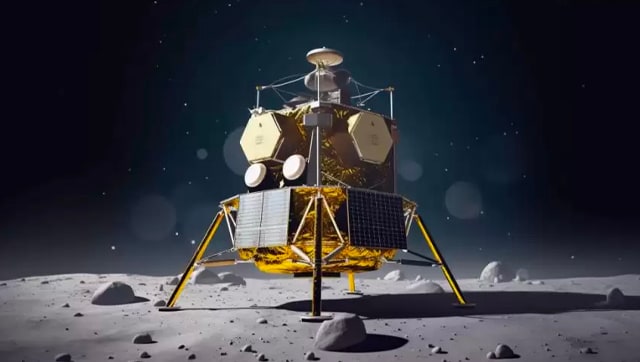
The Chandrayaan 2 orbiter has one of the most sophisticated instruments of any space mission, the Dual-frequency Synthetic Aperture Radar or DFSAR. It is basically a camera that can see in absolute darkness. It recently took a picture of Chandrayaan 3’s Vikram Lander
Chandrayaan 3’s Vikram Lander and Pragyan Rover had been hard at work for 14 days straight on the moon, after which, both of these modules were put to sleep during the long and cold lunar night.
ISRO has shared a photo of the Vikram Lander Module enjoying its period of rest. The cool thing about the photos that ISRO shared was they it was taken by Chandrayaan 2’s Lunar Orbiter.
The Chandrayaan 3 mission’s Vikram lander, which recently entered sleep mode, has been captured in an image taken by the Chandrayaan 2 orbiter. In the photograph, the lander can be observed positioned on the lunar surface, near the Moon’s South Pole, as it awaits the arrival of sunlight.
The image of the Chandrayaan 3’s lander, which was shared by the Indian Space Research Organisation (ISRO), was captured using the Dual-frequency Synthetic Aperture Radar (DFSAR) instrument onboard the Chandrayaan 2 Orbiter. This instrument played a pivotal role in capturing the image of the lander on Wednesday, providing valuable visual data for the ongoing efforts to assess and potentially reactivate the Vikram lander as part of the Chandrayaan 3 mission.
SAR, ISRO explains in a note attached to the post, is an instrument that transmits microwaves in a specific frequency band and receives the same, reflected off of a surface. In very rudimentary terms, think of it like SONAR or RADAR, but instead of sound or radiowaves, the instrument uses microwaves.
SAR enables imaging without the need for any illumination, making it highly useful for remote sensing applications on Earth and other celestial bodies. Moreover, it can “see” beyond the surface as well.
ISRO’s DFSAR, a crucial scientific instrument onboard the Chandrayaan-2 Orbiter, operates using microwaves in the L- and S-band frequency ranges. It stands out as a state-of-the-art instrument, providing the highest resolution polarimetric images currently available on any planetary mission. The longer radar wavelength used by DFSAR enables it to explore subsurface features on the lunar surface down to depths of a few meters.
Over the past four years, DFSAR has been consistently delivering high-quality data by capturing images of the lunar surface. Its primary focus has been on lunar polar science, contributing valuable insights into this region of the Moon.
As for the Vikram Lander and the Pragyan Rover on the Moon ISRO expects that once sunlight returns to the area, the two can be reactivated. ISRO has stated that although the chances of the Rover coming back to life may be extremely low, it had its batteries completely juiced up when it was sent to sleep.
ISRO is pretty confident that the Vikram lander can be reactivated, provided it has endured the harsh cold conditions on the Moon. This development underscores the continued efforts to re-establish communication and functionality with the Vikram lander as part of the Chandrayaan 3 mission.
Stay connected with us on social media platform for instant update click here to join our Twitter, & Facebook
We are now on Telegram. Click here to join our channel (@TechiUpdate) and stay updated with the latest Technology headlines.
For all the latest Technology News Click Here
For the latest news and updates, follow us on Google News.
